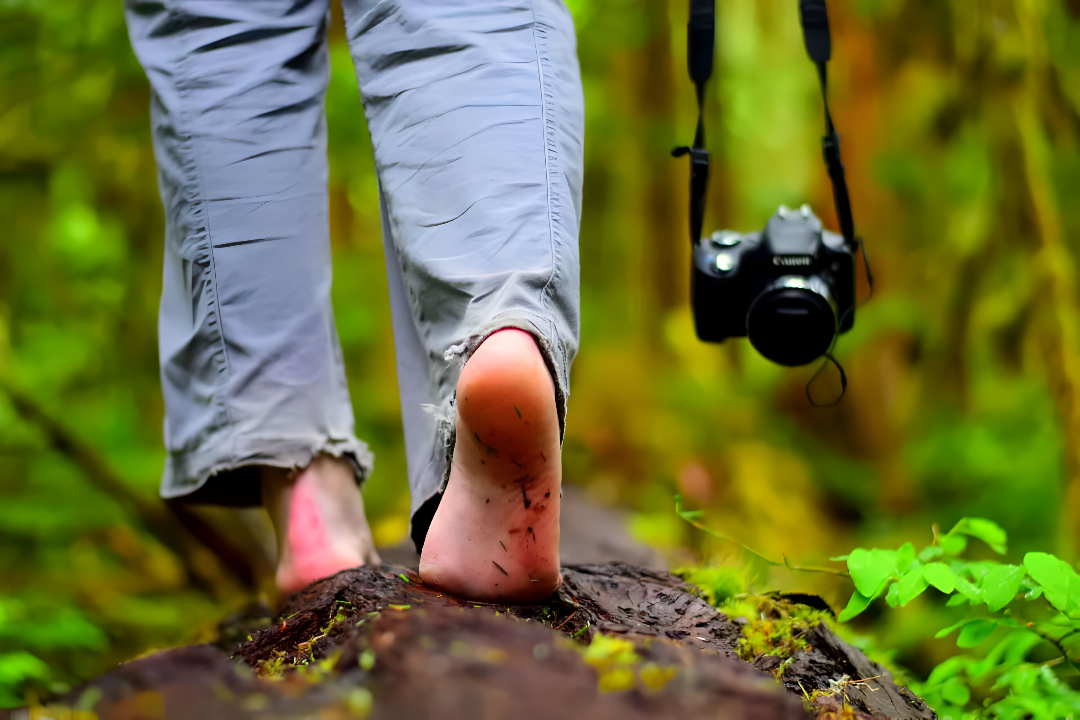Have you ever finished a long walk, taken off your heavy boots, and felt a tremendous feeling of relief? That simple joy has caused many individuals to ask: What if we hiked without shoes from the start? Barefoot hiking is precisely what it sounds like: walking on paths with no shoes. It is a discipline that reconnects us to our most natural mode of movement. But, is it safe? Let’s go over the benefits and drawbacks to help you determine if this is the correct option for you.
1. The Benefits of Feeling the Earth
Abandoning shoes is not about being tough; it is about getting back to basics. The benefits are both physical and psychological.
2. The Many Benefits of Barefoot Hiking
The majority of individuals are drawn to barefoot walking for foot health because of the benefits it provides. First and foremost, it really strengthens your feet. Without a shoe, the small muscles in your feet, ankles, and calves work harder. This can result in improved balance and more stable joints. It also makes your natural walk lighter, encouraging you to land on the balls of your feet instead of your heels. This can make your knees and hips feel better.
3. Direct Connection: Walking to Ground Yourself
One of the best things about going barefoot is the idea of getting grounded through walking. The idea says that touching the ground directly with your skin (like on dirt, grass, or sand) can be good for you. Learn more about grounding and natural movement.
4. Improving Your Foundation: Barefoot Walking for Foot Health
The shape of our feet can change because of modern shoes, and the muscles can become weaker. The goal of going barefoot for health is to change this trend and strengthen your foundation naturally.
5. The Reality of the Trail: Cons and Risks
Even though the idea is interesting, the route isn’t always a flat, open area. It’s essential to be honest about the problems.
6. Understanding the Minimalist Hiking Risks
The most obvious minimalist hiking risks are injuries. Sharp pebbles, thorns, shattered glass, and other sharp items pose a genuine threat. In warmer areas, be cautious of hot surfaces that might burn your soles. In colder temperatures, the Earth can become excruciatingly cold. There is also a danger of cuts becoming infected if not cleansed correctly. This is the most serious safety hazard and cannot be overlooked.
7. The Tough Transition
It hurts your feet! It will hurt on the first day to go from shoes with cushioning to a five-mile trail with rough ground. Because you’ve worn shoes for years, your skin is soft and your muscles are weak.
One of the most serious risks of minimalist hiking is starting too quickly, which can cause strained muscles or stress fractures. The changeover must be extremely slow.
8. Starting Safely: Tips for Your First Barefoot Hike
If you are intrigued, don’t just go into the woods! Follow these precautions to keep safe while enjoying the numerous benefits of barefoot hiking.
-
Begin Small:
Walk barefoot on safe, soft surfaces such as your backyard, a sandy beach, or a well-kept grassy park.
-
Proceed Slowly:
Gradually increase the time and difficulty of the terrain. Allow your skin to toughen and your muscles to adapt over several weeks or months.
-
Choose Your Path Wisely:
Choose a well-known path as your first serious trail. Avoid trails that include sharp rocks, a lot of roots, or visible garbage. A smooth dirt or sand track is ideal.
-
Watch Where You Step:
This is not negotiable. You must be hyper-aware of each step. Plan your course by looking a few steps ahead. -
Clean Your Feet:
After your walk, carefully wash your feet with soap and water. Check for tiny wounds or splinters and treat them immediately.
-
Consider Minimalist Shoes:
Minimalist footwear is a great compromise. They have thin, flexible soles that shield your feet from serious hazards while offering many of the sensory and strengthening benefits of barefoot walking.
9. Is Barefoot Hiking Safe?
The answer is yes, if you are truly careful, patient, and clever about it. The risks involved with minimalist hiking are real, as are the advantages of barefoot hiking. It’s not about favoring one over the other indefinitely. Many hikers like both! They might wear trail shoes for a rocky mountain climb yet still enjoy a barefoot walk along a riverside to feel grounded. The essence of barefoot walking for foot health is listening to your body. Begin carefully, respect the terrain, and you could discover an entirely new way to interact with the earth beneath your feet.
Disclaimer: Always consult a doctor or podiatrist before starting a new physical activity, such as barefoot hiking, especially if you have pre-existing foot issues like diabetes.
Conclusion
Not only a trend, barefoot hiking is a return to a more organic kind of mobility that has special advantages for the body and the mind. The lure is obvious, ranging from the deep sense of grounding that comes with walking to the indisputable benefits of regular barefoot walking for foot health. Respect for the very real minimalist hiking risks associated with leaving your shoes behind is necessary for the adventure, though.
There is no clear winner in the argument between hiking barefoot and wearing trail shoes. It’s a personal decision depending on your objectives, the terrain, and your degree of experience. A gradual change and education are the safest course of action.
Explore more guides on fitness and natural movement at Y Fitness Matters.
